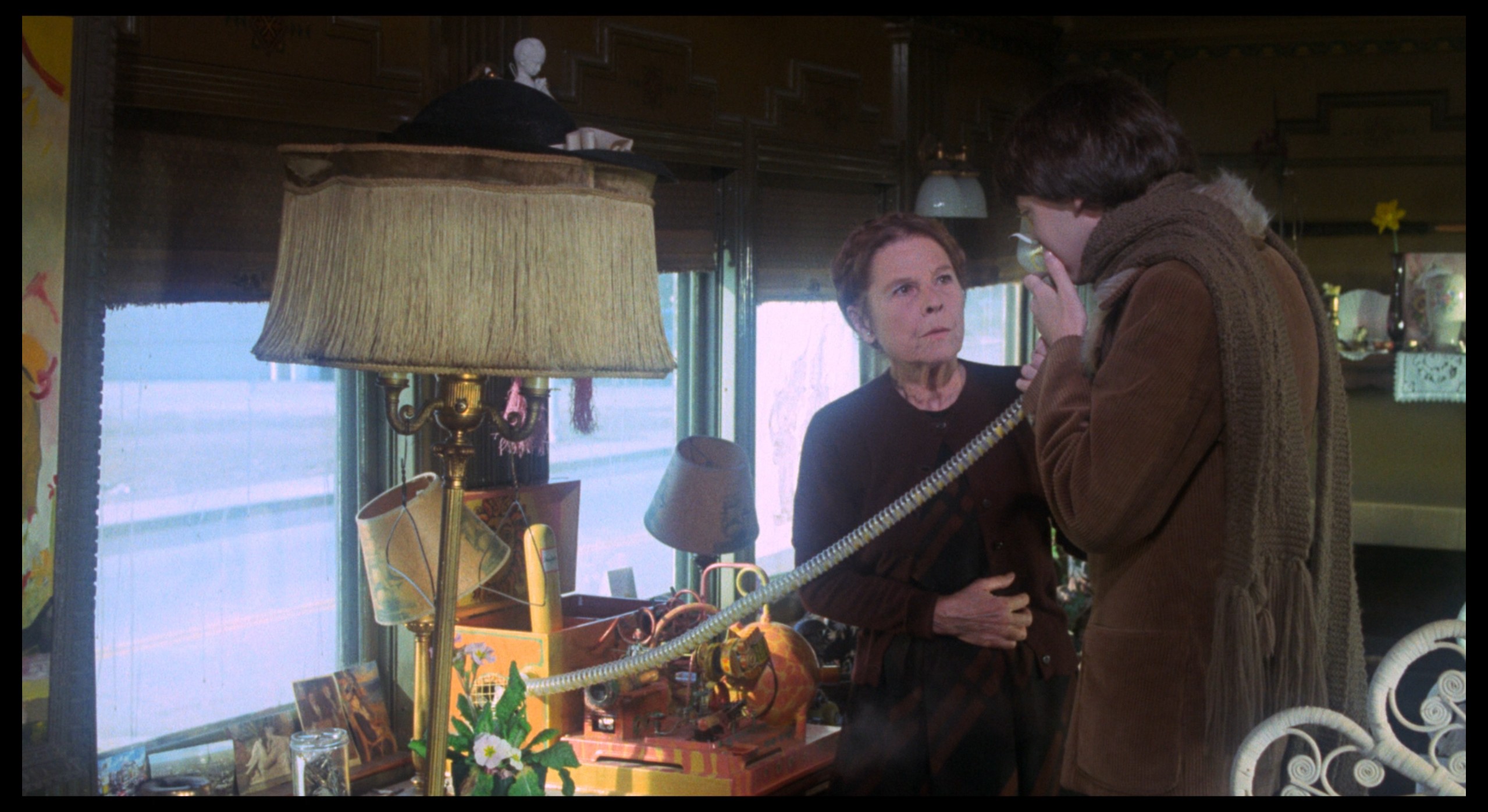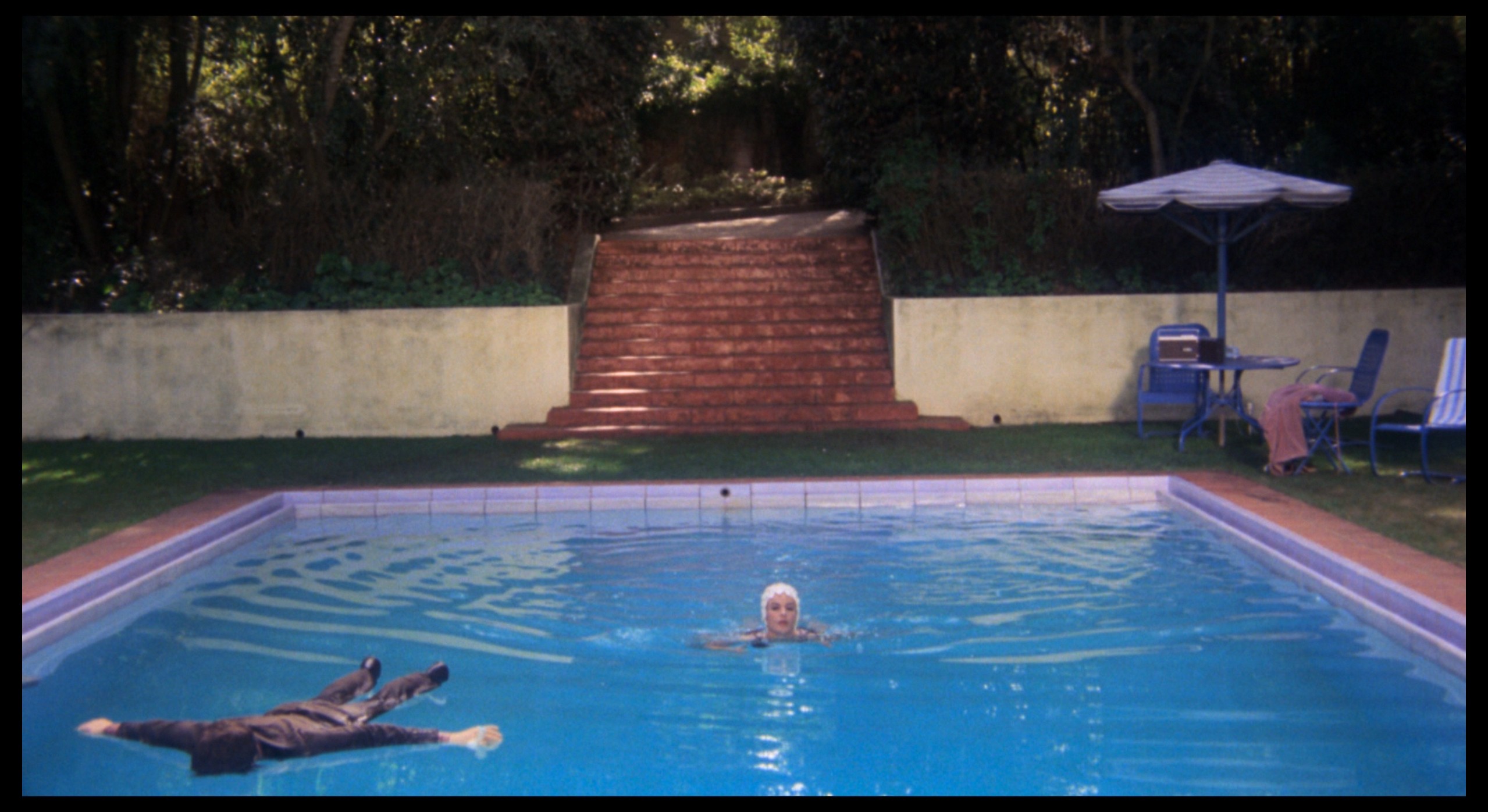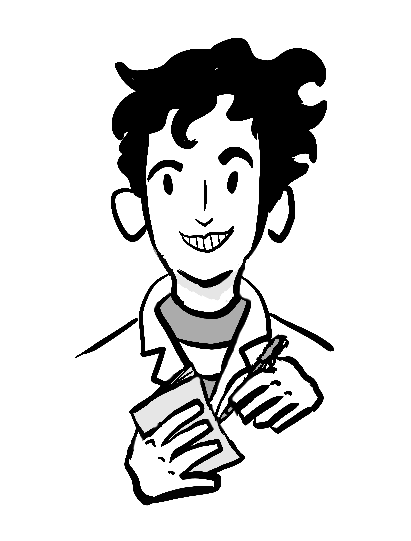By Kyle Brandys
Harold Chasen, (Bud Cort) an affluent twenty-year-oldboy, stands in the slightly dilapidated but no less charming home of Maude Chardin (Ruth Gordon)—also present. Harold looks young for his age, acts older than his twenty years, and has a curious fixation on death: most manifest through the repeated acts of faking his own death via a series of elaborate pranks—on the behalf and to the detriment of, his frustrated mother (Vivian Pickles). Maude is an elderly woman (days away from her 80th birthday, we learn) who has a preference for life, moments of spontaneity: a certain zeal in enacting small acts of rebellion against the regular customs and norms of society. Harold has arrived in the home of Maude Chardin due to a shared interest in the practice of crashing funerals (an attraction between the two is sparked after a few chance encounters at graveyards and cathedrals). Harold, standing in Maude’s living room, is wearing a stylish corduroy coat with fur lining completed by a green scarf coiled tightly around his slender neck. Maude, who was discovered by Harold posing for an ice sculptor that due to his old age needs brief reminders as to “the contours of the female form,” had but recently been wearing absolutely nothing but has since put on a thin burgundy sweater and a matching dress.

Maude’s house is densely packed with the presence of a great variety of anachronistic pleasures, relics, and trinkets. Surrealistic paintings, statues, and religious artifacts adorn the crowded walls of Maude’s modest home. The piece de resistance being an “odorific” machine which emits through its brightly colored tubes, a medley of eccentric fragrances, labeled by Maude as an “olfactory banquet.”
“Give the nose a treat,” Maude says to Harold, about the machine. Harold puts on the breathing apparatus and inhales the mysterious odors.
Harold puts on the breathing apparatus and inhales the mysterious odors (Figure 1).
The smell of an urban subway is displaced by the pleasant aromas of a woman’s perfume. A breath. Cigarettes. A Breath. The smell of a snowfall. The distasteful smells of urban subways and cigarettes seem to only lift, elevate, and sweeten the more pleasant smells awaiting with the subsequent breaths by Harold.
This essay is concerned with and inspired by the oscillation and interplay of bittersweetness found in Maude’s odorific machine. This scene and our two characters are from the 1971 cult classic Harold and Maude, the second film from New Hollywood director Hal Ashby. Together, the two characters belong to the larger outfit of misfits, outsiders, and rebels that populate Hal Ashby’s oeuvre. Going against rather than with the grain, living on the margins lends for the characters from Ashby’s films a certain blissful flavor that comes with non-conformity, while also bringing with it the melancholy loneliness intrinsic to life as an outsider. Among the more adoring fans of Hal Ashby, (I include myself in the category), it is this very aftertaste of bittersweetness that I believe is often found particularly addictive about his films.
For me, Harold and Maude has always been the apex of the bittersweet flavor that accompanies viewing a Hal Ashby film. The viewing experience is a sensorial experience that tickles, flirts, and often overwhelms the five senses.
Harold and Maude takes inspiration from its soundtrack from musician Cat Stevens. The film itself adopts the form of an unwieldy symphony of bittersweet love songs. The relationship between Harold and Maude, from the perspective of Harold, serves the culinary model of appetizer: an item that prepares the palate while refusing satiation. For Maude, the affair is more dessert following the rather large multi-course meal that has been her rambunctious life—a goodbye kiss. Maude kills herself on the day of her 80th birthday, the same day Harold planned to propose and ask for her hand in marriage.
I have selected from the varied assortment of whimsical and melancholy vignettes from Harold and Maude, four moments that best evoke the paradoxical flavors, tones, and feeling of the bittersweet. As previously suggested, feel free to conceptualize these sensations not just as cinematic scenes but also as meal, song, or in the words of Maude, “olfactory banquet.”
Flowers and Tombstones
Maude muses to Harold on themes of identity, uniformity, and self-worth while sitting amidst a sea of flowers: a form of first date for the couple (Figure 2).

“I feel that much of the world’s sorrow comes from people who are this yet allow themselves to be treated as that,” Maude says to Harold, holding one flower, while directing his attention to her points of comparison: which are admittedly waves of nearly identical daisies. Yet, her point is well taken. Through the simple metaphor of flowers, Maude expounds upon her view of the world. An individual’s multitudes cannot be uncovered by quick glances at surface appearances. Her descriptions of the minute details of the flowers— “Some are smaller…some grow to the left”—also invites the inattentive spectator to pay closer attention to the more obscure and hidden “observable differences”—the smaller details contained within visual stimuli. This is a philosophy reinforced in the scene almost immediately by a little formal play by Hal Ashby. The medium close-up of Harold and Maude in the sea of flowers cuts to a wide shot of Harold and Maude now sitting in a different field among the tight ordered rows of tombstones (Figure 3).

This cut to a wide shot replaces the beauty of finding uniqueness in daisies with a similar sentiment towards finding it in the ritualization of the deceased. Tombstones, ubiquitous and largely uniform, are repositories and “finger/footprints” for the forgotten memories of the departed. This simple cut placates the viewer’s demand for orientation (giving an expanded field of vision) while simultaneously producing a sudden discontinuous shift in space and time. Due to Maude’s philosophical waxing, such cinematic formalities as the cut from close to wide shot becomes endowed with the qualities of bitterness and sweetness. Like the metaphor of flowers and tombstones, even the simplest techniques of cinema deserve due attention in the world of Hal Ashby.
Swimming Pools
The depths of suburban swimming pools, it would seem for many of our favorite filmmakers of the 1960s and 1970s, may hide the answers to the many questions of societal disillusionment and youthful ennui that occupied the two decades. The Graduate’s (Mike Nichols, 1967) Benjamin Braddock (Dustin Hoffman), decked in diving gear, famously searched the bottom of his parents’ pool for the solutions to post-graduate life and a burgeoning affair with an older married woman. Alain Delon lounged poolside in the French Riviera, battling temptation and infidelity in La Piscine (The Swimming Pool, Jacques Deray, 1969) What is it about pools that beget feelings of aimlessness, alienation, and loneliness? Perhaps it is the feeling of drifting and floating but still stuck in a confined space. Maybe it is the illusion of depth intrinsic to house pools; with eyes closed, pools seem to have a cavernous depth, but there are few places where one’s feet cannot touch the ground.

Where does Harold and Maude fit into this tradition? Harold Chasen’s own dip into this “pool” comes by the way of another of his famous suicides. Much like the re-appropriation of space in La Piscine, where the vacation space of a pool becomes the setting of a murder in the narrative’s latter half, Harold and Maude portrays a similar duality but instead of narrative structure, it does so through framing. In a beautiful, symmetrical wide shot to the diegetic tunes of classical music, Harold’s mother equipped with proper swimwear (cap, uniform) sinks into the depths of her pool to begin her routine laps. The camera slowly tilts to now reveal Harold face down, seemingly dead, floating in the other side of the pool. The functions of the Chasen swimming pool become divided according to the framing and movement of the camera. The top half of the swimming pool belongs to the activities of the leisurely and athletic: a domestic bliss. As the camera tilts to include the floating corpse of Harold, the entropic forces of Harold’s morbid mischievousness threaten to disrupt his mother’s swimming. Yet, she persists; bitterness and sweetness are forced to co-exist in the frame due to Mrs. Chasen’s ignoring of Harold. As Mrs. Chasen swims down the length of the pool, the left half of the pool and frame is occupied by Harold—the middle and right by his mother (Figure 4).
Irritated by the disregard shown by Mrs. Chasen, the camera dives below the surface of the pool to capture Harold floating incensed, breaking the fourth wall by staring directly into the camera—a perfect bookend for the sequence.
Painful Memories
A shot of interlocked human arms and bodies against the backdrop of a luminous sunset. This is my favorite shot from Harold and Maude. Our protagonists now find themselves having a romantic moment and embrace in what appears to be a largely disregarded junkyard. The duskiness of the departing day paints Harold and Maude as mere silhouettes with their backs to the camera, the sun peeking through the crook of their intertwined arms. Famously, mere seconds before this embrace, an insert shot of Maude’s arm reveals the faded tattooed numbers of an Auschwitz survivor (Figure 5). As the camera begins to zoom, the scene cuts—a quick retreats into the romantic moment.

The facts behind Maude’s time in the Auschwitz concentration camp remain unspoken: locked away from Harold and spectator alike. I have always been fascinated by the brevity of the close-up shot of Maude’s arm. The camera refuses to linger on the arm of Maude, as if the cinematic apparatus has intruded upon a memory it does not have access to. The insert shot of Maude’s arm interplay with the wide shot of Harold and Maude in a romantic embrace continues the beautiful dance of sweetness and bitterness: a defiant refusal to let painful memories stop the formation of new loves and better days.
End of The Road…?
The film’s climax, in which Maude takes her life by overdosing on sleeping pills, is a bittersweet montage. Images of Maude’s death (the ambulance racing down streets, Harold devastated, a doctor walking down a deserted hallway with news of Maude’s death) are intercut with a melancholic Harold and his hearse fleeing from the devastation at a later point of time. This montage eventually culminates with the hearse going over a cliffside, Harold seemingly killed. Much like the iconic endings of Les Quatre Cents Coups (The 400 Blows, François Truffaut, 1959) and La Dolce Vita (The Sweet Life, Federico Fellini, 1960) we end on a beachfront: a literal end of the road.
Yet, it is only one more of Harold’s famous escapes from death. Harold jumped from the cliff at the last second and with a banjo in hand he shimmies away from the camera leading to a freeze frame. Unlike the ending of The 400 Blows, which focuses on a close-up of the face of young Antoine Doinel (Jean-Pierre Léaud), Harold and Maude’s freeze-frame emphasizes Harold’s place in the environment. Harold is turning away from death: his many suicide pranks, the doomed romance with Maude. He is turned, with his back facing away from the camera, towards life: at the intersection of sweetness and bitterness.

Kyle Brandys is an alumnus from the University of North Georgia and a graduate of University of Toronto’s Master’s program in Cinema Studies.
